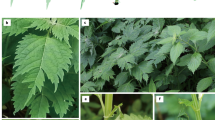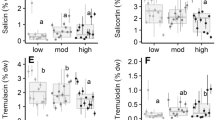Abstract
The effect of leaf shape variation on plant-herbivore interactions has primarily been studied from the perspective of host seeking behavior. Yet for leaf shape to affect plant-herbivore coevolution, there must be reciprocal effects of leaf shape variation on herbivore consumption and performance. We investigated whether alternative leaf morphs affected the performance of three generalist insect herbivores by taking advantage of a genetic polymorphism and developmental plasticity in leaf shape in the Ivyleaf morning glory, Ipomoea hederacea. Across four experiments, we found variable support for an effect of leaf shape genotype on insects. For cabbage loopers (Trichoplusia ni) and corn earworms (Helicoverpa zea) we found opposing, non-significant trends: T. ni gained more biomass on lobed genotypes, while H. zea gained more biomass on heart-shaped genotypes. For army beetworms (Spodoptera exigua), the effects of leaf shape genotype differed depending on the age of the plants and photoperiod of growing conditions. Caterpillars feeding on tissue from older plants (95 days) grown under long day photoperiods had significantly greater consumption, dry biomass, and digestive efficiency on lobed genotypes. In contrast, there were no significant differences between heart-shaped and lobed genotypes for caterpillars feeding on tissue from younger plants (50 days) grown under short day photoperiods. For plants grown under short days, we found that S. exigua consumed significantly less leaf area when feeding on mature leaves than juvenile leaves, regardless of leaf shape genotype. Taken together, our results suggest that the effects of leaf shape variation on insect performance are likely to vary between insect species, growth conditions of the plant, and the developmental stage and age of leaves sampled.





Similar content being viewed by others
References
Agrawal AA (2004) Plant defense and density dependence in the population growth of herbivores. Am Nat 164:113–120
Agrawal AA (2005) Natural selection on common milkweed (Asclepias syriaca) by a community of specialized insect herbivores. Evol Ecol Res 7:651–667
Baucom R, Mauricio R (2008) The evolution of novel herbicide tolerance in a noxious weed: the geographic mosaic of selection. Evol Ecol 22:85–101
Becerra JX (1997) Insects on plants: Macroevolutionary chemical trends in host use. Science 276:253–256
Becerra JX (2003) Synchronous coadaptation in an ancient case of herbivory. PNAS 100:12804–12807
Berenbaum M (1983) Coumarins and caterpillars: a case for coevolution. Evolution 37:163–179
Berenbaum MR, Zangerl AR (1998) Chemical phenotype matching between a plant and its insect herbivore. PNAS 95:13743–13748
Bright K (1998) Geographic variation and natural selection on a leaf shape polymorphism in the Ivyleaf morning glory (Ipomoea hederacea). Ph.D. Dissertation thesis, Duke University, Durham
Brown VK, Lawton JH, Grubb PJ (1991) Herbivory and the evolution of leaf size and shape [and discussion]. Philos Trans Biol Sci 333:265–272
Campitelli BE, Stehlik I, Stinchcombe JR (2008) Leaf variegation is associated with reduced herbivore damage in Hydrophyllum virginianum. Can J Bot, in press
Ehrlich PR, Raven PH (1964) Butterflies and plants: a study in coevolution. Evolution 18:568–608
Elmore CD (1986) Mode of reproduction and inheritance of leaf shape in Ipomoea hederacea. Weed Sci 34:391–395
Ennos RA (1981) Quantitative studies of the mating system in two sympatric species of Ipomoea (Convolvulaceae). Genetica 57:93–98
Farrell BD (1998) “Inordinate fondness” explained: why are there so many beetles? Science 281:555–559
Farrell BD, Sequeira AS (2004) Evolutionary rates in the adaptive radiation of beetles on plants. Evolution 58:1984–2001
Futuyma DJ, Slatkin M (eds) (1983) Coevolution. Sinauer, Sunderland
Gilbert LE (1979) Coevolution of plants and animals: a 1979 post-script. In: Gilbert LE, Raven PH (eds) Coevolution of animals and plants, 2nd edn. University of Texas Press Austin
Gilbert LE (1975) Ecological consequences of a coevolved mutualism between butterflies and plants. In: Gilbert LE, Raven H (eds) Coevolution of animals and plants, 1st edn. University of Texas Press, Austin
Givnish TJ, Vermeij GJ (1976) Sizes and shapes of liane leaves. Am Nat 110:743–778
Givnish TJ (1979) On the adaptive significance of leaf form. In: Solbrig OT, Jain S, Johnson GB, Raven PH (eds) Topics in plant population biology. Columbia University Press, New York, pp 375–407
Givnish TJ (1990) Leaf mottling: relation to growth form and leaf phenology and possible role as camouflage. Funct Ecol 4:463–474
Gómez JM, Zamora R (2000) Spatial variation in the selective scenarios of Hormathophylla spinosa (Cruciferae). Am Nat 155:657–668
Gómez JM, Zamora R (2002) Thorns as induced mechanical defense in a long-lived shrub (Hormathophylla spinosa, Cruciferae). Ecology 83:885–890
Hull-Sanders HM, Eubanks MD (2005) Plant defense theory provides insight into interactions involving inbred plants and insect herbivores. Ecology 86:897–904
Hull-Sanders HM, Eubanks MD, Carr DE (2005) Inbreeding depression and selfing rate of Ipomoea hederacea var. integriuscula (Convolvulaceae). Am J Bot 92:1871–1877
Ikonen A (2002) Preferences of six leaf beetle species among qualitatively different leaf age classes of three Salicaceous host species. Chemoecology 12:23–28
Johnson MTJ (2008) Bottom-up effects of plant genotype on aphids, ants, and predators. Ecology 89, in press
Jones CG, Coleman JS (1988) Leaf disc size and insect feeding preference: implications for assays and studies on induction of plant defense. Entomologia Experimentalis et Applicata 47:167–172
Littell RC, Milliken GA, Stroup WW, Wolfinger RD (1996) SAS System for mixed models. SAS Institute, Cary
MacKay DA, Jones RE (1989) Leaf shape and the host-finding behaviour of two ovipositing monophagous butterfly species. Ecol Entomol 14:423–431
Mauricio R, Rausher MD (1997) Experimental manipulation of putative selective agents provides evidence for the role of natural enemies in the evolution of plant defense. Evolution 51:1435–1444
McKey D (1974) Adaptive patterns in alkaloid physiology. Am Nat 108:305–320
Moran N (1981) Intraspecific variability in herbivore performance and host quality—a field-study of Uroleucon-Caligatum (Homoptera, Aphididae) and its solidago hosts (Asteraceae). Ecol Entomol 6:301–306
Niemela P, Tuomi J (1987) Does the leaf morphology of some plants mimic caterpillar damage? Oikos 50:256–257
Ohnmeiss TE, Baldwin IT (2000) Optimal defense theory predicts the ontogeny of an induced nicotine defense. Ecology 81:1765–1783
Pilson D, Rausher MD (1995) Clumped distribution patterns in goldenrod aphids: genetic and ecological mechanisms. Ecol Entomol 20:75–83
Rausher MD (1978) Search image for leaf shape in a butterfly. Science 200:1071–1073
Rausher MD (1981) Host plant selection by Battus philenor butterflies—the roles of predation, nutrition, and plant chemistry. Ecol Monogr 51:1–20
Rausher MD (2001) Co-evolution and plant resistance to natural enemies. Nature 411:857–864
Rausher MD, Simms EL (1989) The evolution of resistance to herbivory in Ipomoea purpurea. I. Attempts to detect selection. Evolution 43:563–572
Rivero-Lynch AP, Brown VK, Lawton JH (1996) The impact of leaf shape on the feeding preference of insect herbivores: experimental and field studies with Capsella and Phyllotreta. Philos Trans Biol Sci 351:1671–1677
Schadler M, Jung G, Auge H, Brandl R (2003) Palatability, decomposition and insect herbivory: patterns in a successional old-field plant community. Oikos 103:121–132
Simonsen AK, Stinchcombe JR (2007) Induced responses in Ipomoea hederacea: simulated mammalian herbivory induces resistance and susceptibility to insect herbivores. Arthropod-Plant Interact 1:129–136
Simms EL, Rausher MD (1989) The evolution of resistance to herbivory in Ipomoea purpurea. II. Natural selection by insects and costs of resistance. Evolution 43:573–585
Shonle I, Bergelson J (2000) Evolutionary ecology of the tropane alkaloids of Datura stramonium L. (Solanaceae). Evolution 54:778–788
Smith AP (1986) Ecology of a leaf color polymorphism is a tropical forest species – Habitat segregation and herbivory. Oecologia 131:283–287
Stinchcombe JR (2002) Fitness consequences of cotyledon and mature-leaf damage in the ivyleaf morning glory. Oecologia 131:220–226
Stinchcombe JR, Rausher MD (2001) Diffuse selection on resistance to deer herbivory in the ivyleaf morning glory, Ipomoea hederacea. Am Nat 158:376–388
Stinchcombe JR, Rausher MD (2002) The evolution of tolerance to deer herbivory: modifications caused by the abundance of insect herbivores. Proc R Soc Lond Ser B Biol Sci 269:1241–1246
Strauss SY, Irwin RE, Lambrix VM (2004) Optimal defence theory and flower petal colour predict variation in the secondary chemistry of wild radish. J Ecol 92:132–141
Tétard-Jones C, Kertesz MA, Gallois P, Preziosi RF (2007) Genotype-by-genotype interactions modified by a third species in a plant-insect system. Am Nat 170:492–499
Thompson JN (2005) The geographic mosaic of coevolution. University of Chicago Press, Chicago
Weis AE, Abrahamson WG (1986) Evolution of host-plant manipulation by gall makers: Ecological and genetic factors in the Solidago-Eurosta system. Am Nat 127:681–695
Williams KS, Gilbert LE (1981) Insects as selective agents on plant vegetative morphology: egg mimicry reduces egg laying by butterflies. Science 212:467–469
Zangerl AR, Berenbaum MR (2005) Increase in toxicity of an invasive weed after reassociation with its coevolved herbivore. PNAS 102:15529–15532
Acknowledgements
We thank R.F. Sage, B. Hall, A. Petrie, D. Tam, R. Dinnage, A. Xu, and N. Sathiyanathan for their generous help in performing our experiments, and M. Berenbaum and two anonymous reviewers for comments on the manuscript. Our research is supported by NSERC Canada, the University of Toronto Connaught Fund, and the Department of Ecology and Evolutionary Biology at the University of Toronto
Author information
Authors and Affiliations
Corresponding author
Additional information
Handling editor: May Berenbaum.
Rights and permissions
About this article
Cite this article
Campitelli, B.E., Simonsen, A.K., Rico Wolf, A. et al. Leaf shape variation and herbivore consumption and performance: a case study with Ipomoea hederacea and three generalists. Arthropod-Plant Interactions 2, 9–19 (2008). https://doi.org/10.1007/s11829-007-9028-x
Received:
Accepted:
Published:
Issue Date:
DOI: https://doi.org/10.1007/s11829-007-9028-x




